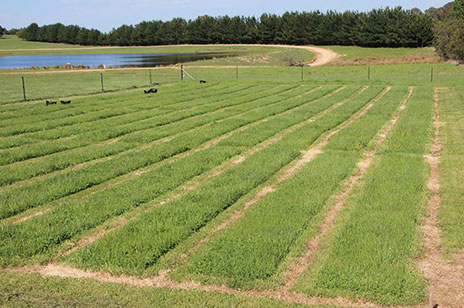
BioAg
Trial
Location
Crookwell, NSW, Australia
Conducted by
BioAg
Crookwell replicated pasture multi-year trials
Phosphorus (P), sulphur (S) and calcium (Ca) are all-important nutrients for a quality pasture.
P is essential for plant growth. It plays a role in photosynthesis, respiration, energy storage and transfer, cell division, cell enlargement and many other vital plant functions. Phosphate helps promote early root formation and growth, it is a large contributor to yield and profitability in pastures and crops and it assists in the transportation of nutrients.
S is used by plants to help with nitrogen metabolism, enzyme activity and protein and oil synthesis. It also helps stimulate soil biology, rumen biology and helps maximizes wool tensile strength.
Ca is also important in root and shoot stimulation, helps with the mechanical strength of the plant (integrity and selectivity of cell membranes), activates several enzyme systems, helps neutralise organic acids within the plant, is essential for good seed set in subterranean clovers. It can also help stimulate microbial activity and molybdenum availability.
Both Single Super Phosphate (SSP) and Superb (BioAg) supply these three main ingredients.
SSP has been the mainstay of pasture production in Australia for a long time, but with changing ideals in agricultural communities, the use of ‘non-chemical’ based fertilisers is rising. Superb is a blend of 2 naturally occurring products, being BioAgPhos (derived from reactive phosphate rock) and Gypsum.
BioAgPhos is a unique fertiliser that provides pastures and crops with an immediate and continuing source of plant-available phosphate. It is made by digesting reactive phosphate rock (sourced from Algeria) with our proprietary microbial culture, which is designed to further break down the rock and improve nutrient availability to plants.
Aim
To assess and measure pasture dry matter response over time, comparing BioAg treatments (annual and biennial) with annual treatments of single super phosphate (SSP).
Method
The trial site selected and soil tested in 2014 and then again in 2018 to look at nutrient run-down Treatments were then applied (hand spread) based on district standard treatment (125kg/ha SSP – 11kg phosphorus (P) per hectare per year):
- Nil
- SSP – annual application
- Superb – annual application
- Superb – biennial application
- BioAgPhos – annual application
- BioAgPhos – biennial application
The trial site did offer the opportunity to include 6 other replicated treatments; these were used to research other treatments and had no impact on the aim, purpose or conclusions of the trial.
Plots were mown on a cut and carry basis (i.e. all mown material was removed from plots). No stock grazing was allowed although there was some accidental grazing from lambs in the spring of 2016 – two cuts were lost.
Treatments were re-applied as needed on an annual or biennial basis. Total of 22 cuts were taken over a 4 year period finishing in the autumn of 2018. Forage quality tests were also taken in the spring of 2017.
Results
At the end of the trial the two Superb treatments produced more dry matter than SSP. SSP produced the third-highest amount of dry matter, better than both BioAgPhos treatments while all treatments out-performed the nil treatment. The treatments containing Sulfur (SSP and the two Superb treatments) were significantly better than the straight phosphate products (BioAgPhos).

Conclusion
Dry matter production on the plots receiving a biennial (every second year) application of Superb was the highest, however not statistically different than for annual applications of either Superb or SSP. The trials aims were achieved and showed that both annual and biennial applications were as effective as SSP in the production of dry matter. The trial also highlighted the benefit of fertiliser in growing additional feed, and that the use of fertiliser was more economical than the buying of feed. The cost of feed production was lowest with biennial applications of Superb.
Download BioAg trial
For the full trial, including methods, results and conclusion, download here.

Recent Comments